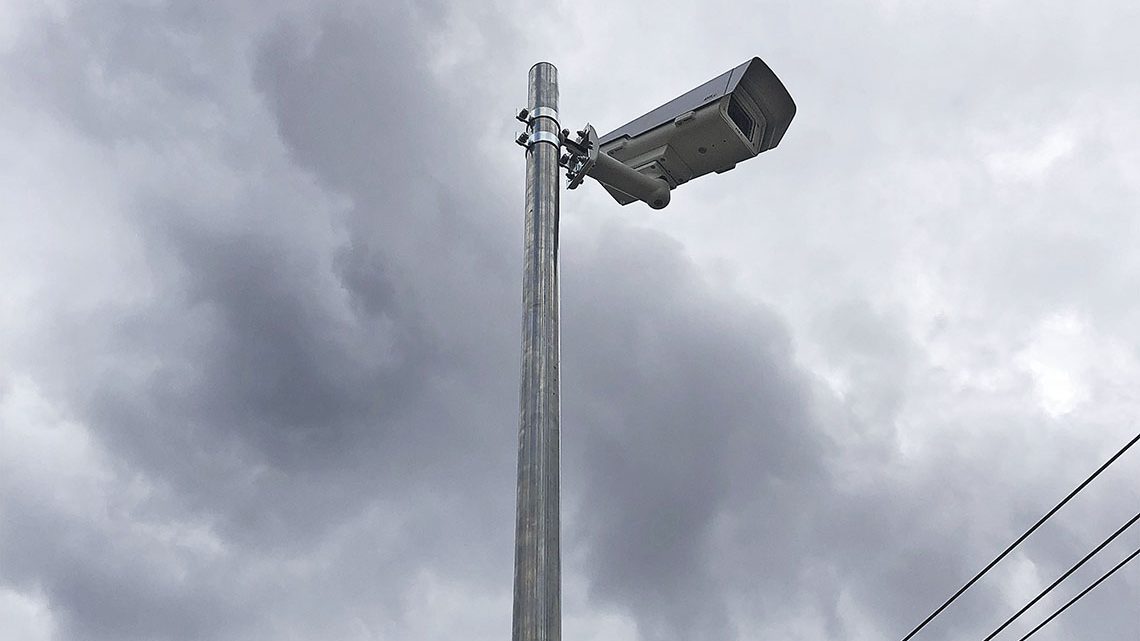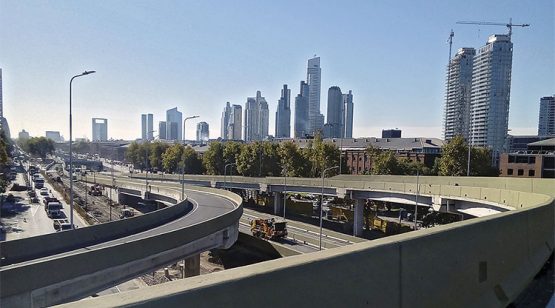The entry into force of the new regulations on Operational Safety and Railway Interoperability (Royal Decree 929/2020, of 27 October) has entailed a comprehensive review of all railway regulations and has improved and completed those implemented in 2001. With the development of these regulations, the Spanish State Agency of Rail Safety has taken an important step forward to ensure the safety of the network and, in particular, of those elements that have the greatest impact on people.
As of 1 January 2021, Spain’s Railway Infrastructure Administrator (Adif) has in its inventory and manages 3,114 level crossings located on the General Interest Railway Network, of which 1,123 have one of the types of active protection established in the aforementioned new R.D. 929/2020. In this regulation, the criteria for the application of protection classes have changed in relation to the previous legislation, which means that the number of level crossings that must have active protection will be increased, prioritising those with passive protection that lack sufficient visibility and present a significant accident rate.
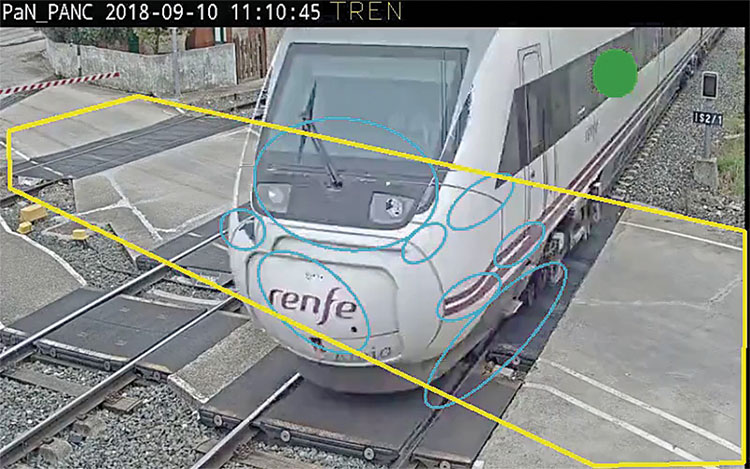
NEW TECHNOLOGIES. These include the incorporation of artificial vision systems that provide real-time information on any incident occurring on the road next to the crossing. / PHOTO_ADIF
Artificial vision in real time
In recent years, Adif has been installing new technologies at level crossings, achieving higher levels of safety and reliability. One of the major technological innovations is the incorporation of artificial vision systems that inform in real time about any incident or obstruction on the track next to the crossing. The cameras discriminate and detect the occupation of the space by any type of vehicle that could be the cause of an accident. Installation is quick, low-cost and requires little maintenance.
Both electromagnetic detection systems (coils) and artificial vision systems trigger the necessary warnings for the protection of the intersection, activate the corresponding signalling on the track and warn the driver of the obstacle.
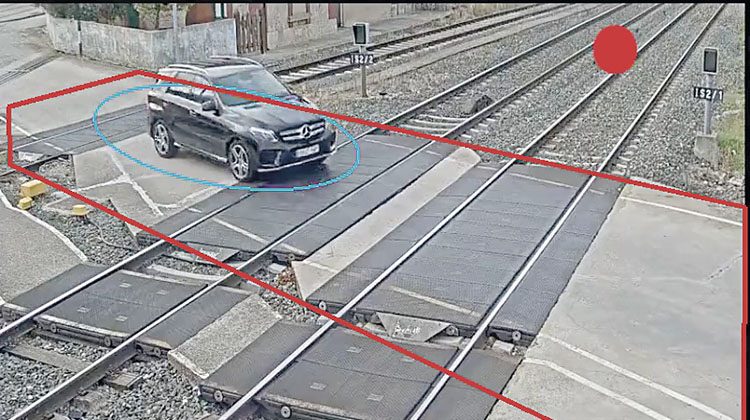
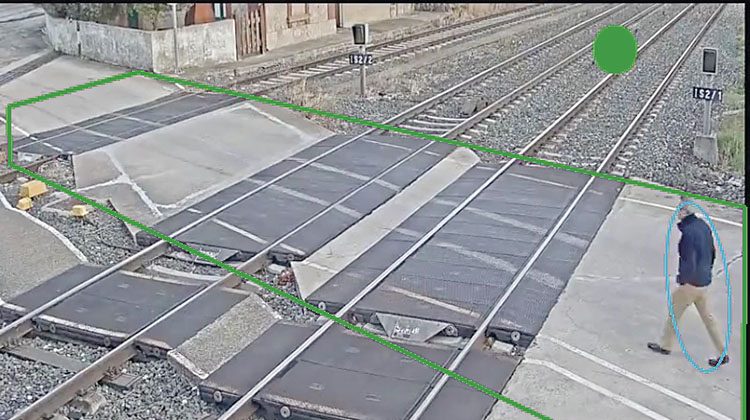
New technologies based on solar energy
New protection systems based on solar energy contribute to sustainable development by reducing energy consumption by up to 75%. Furthermore, their installation does not require the construction of trenches with long cables running to the elements installed in the field, which significantly reduces their environmental impact and eliminates the risk of accidents, as there are no people working in the vicinity of the track.
The electronic technology is designed to be programmable and is compatible with all current systems, including the European signalling system (ERTMS-ETCS).
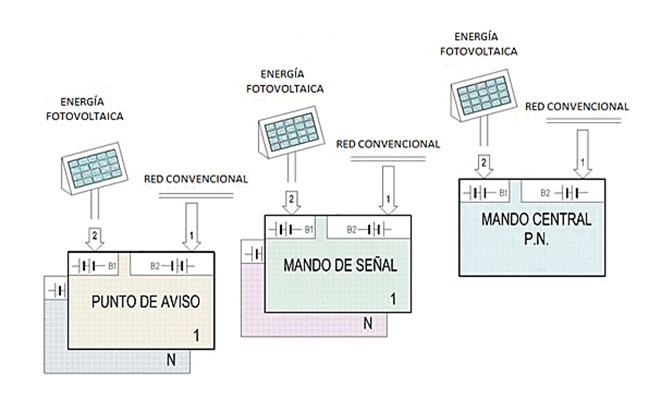
Diagram showing the application of photovoltaic panels.
Recorders acting as a black box
The recorders store, memorise and retain all information, events and movements at the level crossing. With the centralisation of the recorders at each level crossing, information is available in real time in a control centre located at stations or workplaces where the user terminal is installed, and which can be expanded as more level crossings are protected.
The implementation of these systems throughout the Adif network will enable real-time control of all connected intersections. The new developments envisage more secure versions against possible cyber-attacks, which also serve as a legal record and are adapted to the new data protection law.
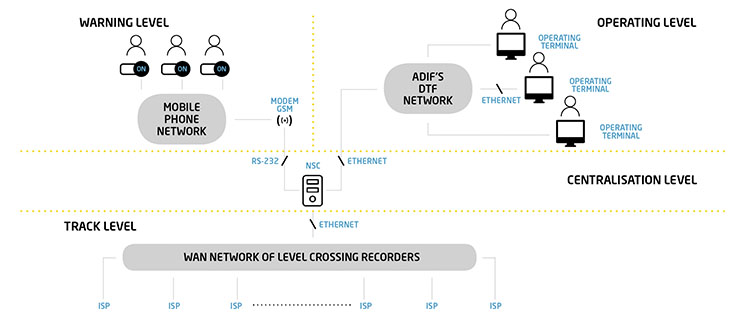
SYSTEM ARCHITECTURE. Example of the communication between level crossings and the Adif central server.
The concentration of recorders helps and facilitates the search for the cause of an incidence at a level crossing, either in its functionality or due to an incident. These systems consequently help in the preventive and predictive maintenance of the facilities, being able to anticipate the origin of an accident. They function as a black box, since, once a possible cause has been detected, all movements occurring at the facilities can be monitored. Even if communication is lost, the data is stored at the level crossing itself and can be retrieved once the connection has been re-established. This structure provides access to each of the recorders from a terminal and enables the records to be downloaded remotely. The system collects the information, stores it for later use and analyses it to detect possible incidents.
30 years of collaboration between Ineco and Adif
Ineco has been collaborating with Adif since the late 1990s in the development of new level crossing protection systems. The company has more than 30 years of experience in Spain and abroad, collaborating with Adif’s Level Crossings Department since 1998 in the drafting of projects, provision of technical assistance and project management.
In 2009, Adif commissioned Ineco to provide technical assistance for the concentration of recorders and safety supervision at 263 crossings located on different lines of the railway network. The company then took charge of the layout work, controlled the installation of equipment and was responsible for testing and commissioning.
Abroad, major work was carried out in 2013 and 2014 on the signalling of more than five hundred crossings on the two main sections of the Ecuadorian railway network.
Ineco experts still continue to participate and collaborate in the drafting of projects, project management for the installation of new protection devices, and innovation and development of new equipment together with Adif.
The new level crossing regulations
According to the new R. D. 929/2020, of 27 October, level crossings are classified according to their ownership (public or private); their useful life (permanent or temporary) and their specific use (vehicles, although they can also be used by pedestrians and livestock).
The regulations stipulate that new level crossings on roads or paths should be at a different level and that, at the request of the owner or the local council, higher classes of protection than the corresponding class or exclusive pedestrian routes can be installed, even if they are not required.
It also makes clear that, in those sections of line where the distance between level crossings is equal to or less than 500 metres, they must be concentrated into a single crossing. The concentration of level crossings not more than 1,000 metres apart measured along the track is also recommended.
Protection classes:
Class P: level crossings with passive protection, i.e. which do not have any warning or protection system to warn the user (driver or pedestrian) of the arrival of the train.
Class A: level crossings with active protection, i.e. they have a warning and/or protection system that warns the user of an approaching train. Within this type, the following are distinguished:
- Class A1 (manual protection): the warning or protection is triggered or carried out manually by railway staff. They are regulated by a mandate from the infrastructure manager.
- Class A2 (automatic protection with user-side warning): he warning to the user is triggered automatically by the approaching train or as a consequence of the establishment of a route affecting its passage.
- Class A3 (automatic protection with user-side warning): protection for the user is triggered automatically by the approaching train or as a consequence of the establishment of a route affecting its passage. This class includes level crossings which are equipped with protection as well as with user warning devices.
- Class A4 (automatic protection with track-side protection): a signal or a train protection system allows users to normally cross the level crossing after checking that it is fully protected on the user’s side and is unobstructed.
Alfonso Escalera Alonso (Adif)
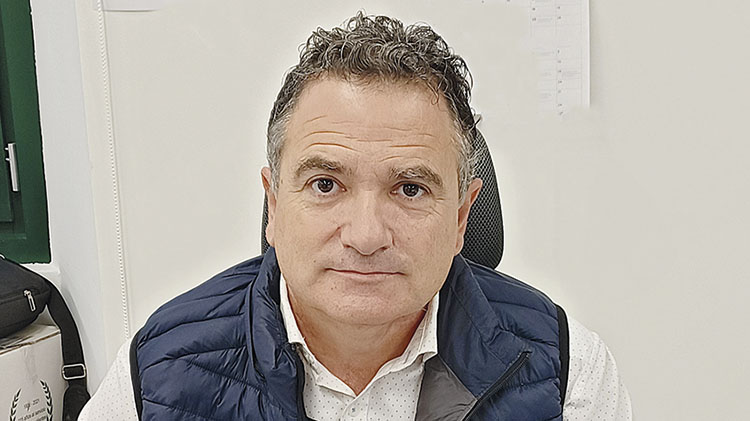
The Spanish protection system: an international reference that complies with the SDGs
Por Alfonso Escalera Alonso, Industrial Electronics Engineer and Head of Level Crossing Protection in Adif
The publication and approval of Annex VII of Royal Decree 929/2020 enabled new criteria for level crossing protection to be defined, one of the most important referring to visibility. This new concept has been a decisive step forward, improving and completing the AxT concept (the moment of traffic is equivalent to the product of cars per train on an average day of the year), which was used in the old legislation.
The new regulation therefore opens the door to the use of adaptations and developments such as artificial vision cameras. These additions contribute to the achievement of the United Nations Sustainable Development Goals (SDGs), which include promoting reliable, sustainable and quality infrastructures, as well as modernising them so that they are compatible with clean and environmentally sound technologies and industrial processes.
Adif’s involvement in the development and protection of level crossings dates back to the 1970s. Since the introduction of semi-automatic barriers at level crossings in 1987, Adif has gradually begun to install a local system for monitoring operation known as the event recorder. Similar to aircraft black boxes, this permanently recorded everything that occurred at the level crossing. The equipment, installed in the level crossing hut, had three recording levels, but only allowed data to be collected at the level crossing itself, downloading it to a computer using a specific software programme. The need to consult the records on site created a problem for the maintenance staff, as it was impossible for them to detect the fault in advance. Therefore, the idea arose of accessing the information remotely by terminal and in real time to facilitate maintenance and even carry out the repair with the necessary spare parts already known in advance, which meant increased cost-cutting in manpower and safety.
Spanish regulations have become a reference for railway safety in many other countries. Adif’s long experience has consolidated its international presence and recognition and its participation in prestigious forums both in the EU and abroad, providing collaboration, knowledge and certification of equipment compatible with its facilities to those countries that request collaboration. In order to be at the forefront, the Level Crossings Department works closely with Spanish industry in the development of these systems. Companies approved with Spanish technology for level crossings work in five continents, installing equipment in Australia, Croatia, Denmark, Cuba, Chile, Ecuador, Egypt, Morocco, Uruguay and Turkey. The equipment is adjusted to the special conditions and circumstances imposed by each country, making it highly versatile and adaptable to different conditions.
At the end of the European Year of Rail, it is important to mention the close cooperation between industry and public administrations in providing the necessary legal, economic and technical means to improve communications, reduce risks and maximise safety at level crossings.


